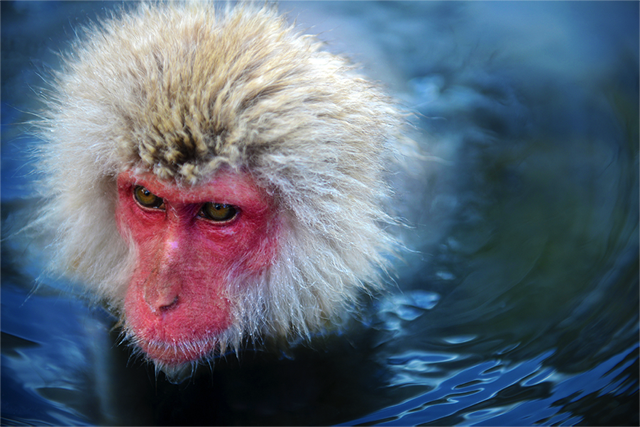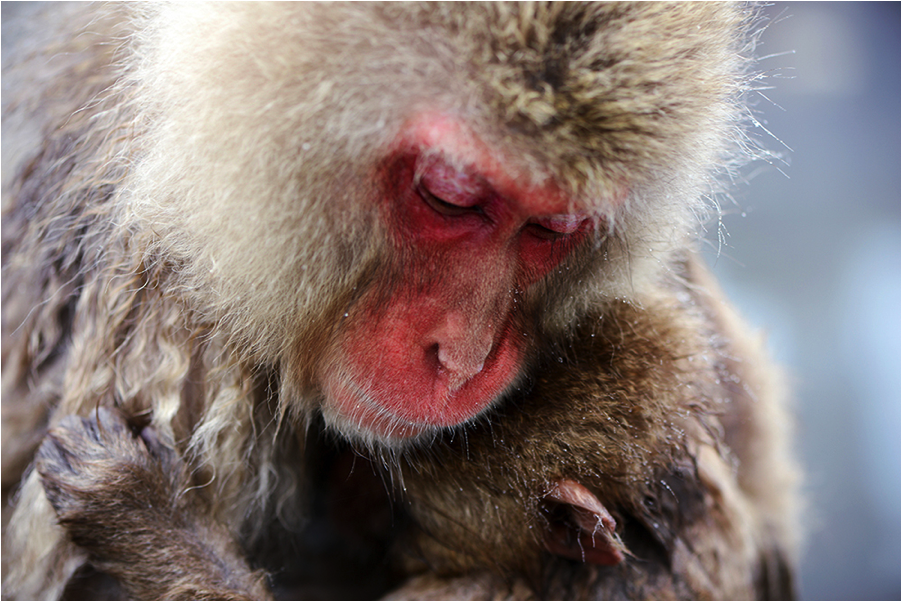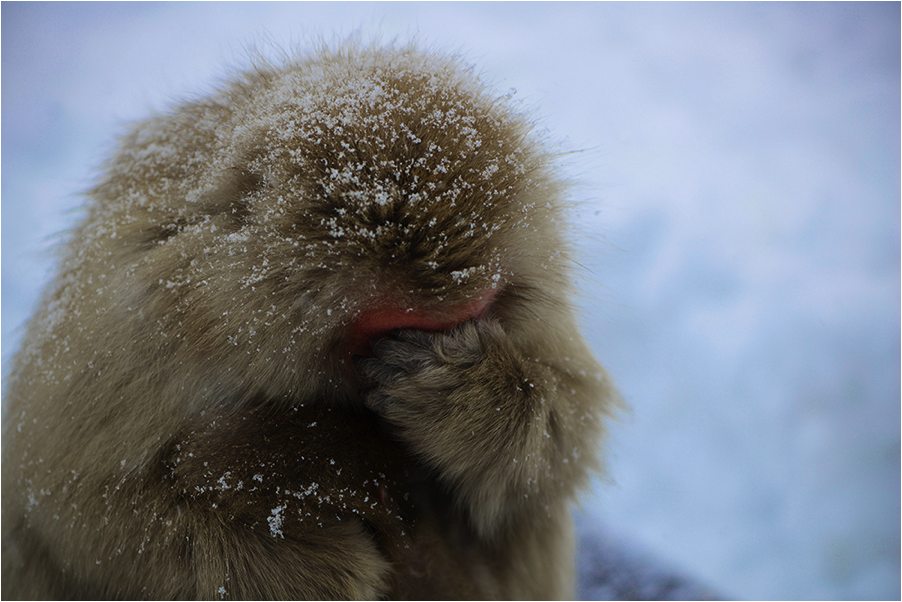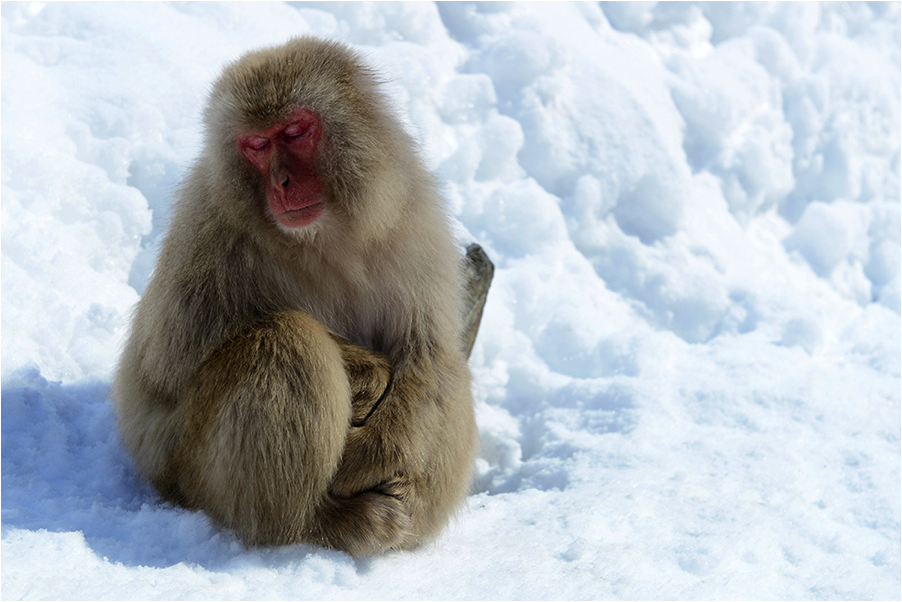Jigokudani means Hell Valley in Japanese, and received this moniker long before monkeys began monkeying around in the Yokoyu River. The valley in this region of Nagano Prefecture has steep cliffs, with hot water that steams when it comes to the surface. Jigokudani-koen is one of the few places on earth where monkeys bathe.
The snow monkeys aren’t the only attraction in the park. The Jigokudani fountain of Shibu is a national monument that has been venting hot water for centuries. In 1783, it abruptly halted when Mount Asama erupted. Mount Asama is the most active volcano in the Honshu region and has erupted several times since the early 1980s. Volcanic eruption that result in steam is known as Jigoku (Hell) phenomenon. The water that gushes forth is salty, yet crystal clear. The pristine water from this area supplies Shibu-onsen and Kanbayashi-onsen. Another onsen, Korakukan, opened in 1864 and is considered a therapeutic bathing facility.
About two hundred Japanese Macaque call this place home. The monkeys form close bonds with others in the group. Some of their facial expressions, and mannerisms are almost human. It’s truly an amazing place to visit.
Despite the close proximity between human interaction and the monkey business that goes on at the park, tourists are warned not to touch or to make eye contact with the local inhabitants. This is because the monkeys may feel threatened, and try to scare or even bite in response. In monkey society, direct eye contact is a sign of hostility, and aggression. Visitors are also warned not to feed the animals, as they would inevitably expect a handout from everyone. In the past the monkeys have also been known to steal handbags, and other items. So, keep in mind that these are wild animals. They are not pets. In that, the monkeys were incredibly docile and quite used to the presence of humans.
When did the monkeys begin using the hot spring? Local facilitators of the park began to artificially feed the monkeys as far back as 1964. As a result, the monkeys stay longer in the park, and have more free time to relax while waiting for their next feeding. One cold day, a younger monkey went into the water. Others began to follow. It wasn’t long before the majority of the monkeys started to bathe. Despite becoming famous for being water creatures, some do not like bathing at all. However, on very cold days, many will bathe for a couple hours at a time.
Monkeys that live in such extreme weather conditions are unique in the world. It’s believed that the monkeys bathe in the hot water due to the extreme cold, as they don’t seem too interested in bathing during the summer season. It’s reported that they rely on each other in just about every aspect of their life. The Macaque are not entirely peaceful, and they do have conflicts and are often injured in their fights. Usually the larger offspring dominate the others. Not so with the snow monkeys. Among brothers and sisters, younger ones receive a higher ranking under their mother’s protection. It’s said that the mother’s protection exists to avoid fighting within the group.
I discovered through literature provided by the park that the snow monkeys mainly communicate through sight. They read mood by observing other monkeys’ expressions and emotions. Although it’s not considered language, they use sounds to warn each other of danger, to intimidate intruders from other groups, and to signal their presence. It’s said they express their feelings through variations of tone and volume. According to the park staff, the monkeys have an amazing ability to “read between the lines.”
The monkeys of Jigokudani Yaen-koen don’t sleep in dens. Of course, animals that sleep in den usually purge outside the den. As a result, the monkeys “go” anywhere. So, be careful where you walk. You’ve been warned.
The Macaque sleep in the safety of steep cliffs or branches of a tree. They huddle with immediate family members or their closest friends. They also hold hands and legs while sleeping together. Few sleep alone.
The monkeys are fed barley, soybeans and even apples, depending on the season. In autumn the monkeys have a greater variety of food such as grapes and chestnuts that they can easily find in abundance in the nearby mountains. To keep them around, the caretakers dole out apples to entice them to stay. I learned that the snow monkeys generally are not attracted to human food. Obviously, feeding is intended to entice the monkeys to stay in the park, which attracts tourists. But it is also a way to keep them under observation, and to study their behavior in as close to a natural habitat as possible.
Below is a link to a more in-depth reading about the Japanese Macaque that live in Jigokudani Yaen-koen.
http://jigokudani-yaenkoen.co.jp/english/html/jigokudani_geology.htm
Directions
From Nagano take a bus or train to Yudanaka. A bus service from Yudanaka runs to Kanbayashi Onsen Iriguchi. There’s a great museum up the hill from the bus stop. It’s free! There are great photos on display in that museum. The walk to Jigokudani Yaen-koen is approximately another thirty minutes. It’s a fantastic journey in the winter and the entrance fee is insignificant for the amount of pleasure and excitement you will receive. March is said to be the best time to go, so what are you waiting for?
For more information contact:
Jigokudani Yaen-koen Inc.
6845 Yamanouchi-machi Shimotakai-gun
, Nagano Japan 381-0401
Phone: 0269-33-4379
Main image: A snow monkey takes a dip in the Yokoyu River onsen.
Updated On December 26, 2022












